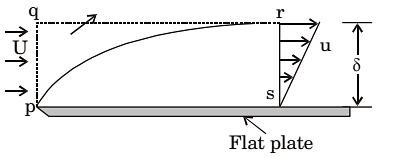Test: Boundary Layer Theory, Laminar Flow - 2 - Mechanical Engineering MCQ
30 Questions MCQ Test GATE Mechanical (ME) Mock Test Series 2025 - Test: Boundary Layer Theory, Laminar Flow - 2
Which one of the following is the characteristic of a fully developed laminar flow?
The MINIMUM value of friction factor ‘f’ that can occur in laminar flow through a circular pipe is:
| 1 Crore+ students have signed up on EduRev. Have you? Download the App |
A smooth flat plate with a sharp leading edge is placed along a gas stream flowing at U = 10 m/s. The thickness of the boundary layer at section r - s is 10 mm, the breadth of the plate is 1 m (into the paper) and the density of the gas ρ = 1.0 kg/m3 . Assume that the boundary layer is thin, two-dimensional, and follows a linear velocity distribution, u = U(y/δ), at the section r - s , where y is the height from plate.
The integrated drag force (in N) on the plate, between p - s , is:

In the region of the boundary layer nearest to the wall where velocityis not equal to zero, the viscous forces are:
The hydrodynamic boundary layer thickness is defined as the distance from the surface where the
Assertion (A): The 'dimples' on a golf ball are intentionally provided.
Reason (R): A turbulent boundary layer, since it has more momentumthan a laminar boundary layer, can better resist an adverse pressure gradient.
During the flow over a circular cylinder, the drag coefficient dropssignificantly at a critical Reynolds number of 2 × 105. This is due to
What is the commonly used boundary layer control method to prevent separation?
Prandtl number of a flowing fluid greater than unity indicates that hydrodynamic boundary layer thickness is:
Velocity defect in boundary layer theory is defined as
Velocity distribution in a turbulent boundary layer follows
Assertion (A): The thickness of boundary layer cannot be exactlydefined.
Reason (R): The Velocity within the boundary layer approaches theinviscid velocity asymptotically.
The equation of the velocity distribution over a plate is given byu = 2y – y2 where u is the velocity in m/s at a point y meter from theplate measured perpendicularly. Assuming μ = 8.60 poise, the she arstress at a point 15 cm from the boundary is:
How is the displacement thickness in boundary layer analysis defined?
Consider the following statements comparing turbulent boundarylayer with laminar boundary layer:
1. Turbulent boundary layers are thicker than laminar boundary layer
2. Velocity in turbulent boundary layers is more uniform3. In case of a laminar boundary layer, the thickness of the boundarylayer increases more rapidly as the distance from the leading edgeincreases.
4. For the same local Reynolds number. Shear stress at the boundaryis less in the case of turbulent boundary layer.
Of these statements:
Assertion (A): In an ideal fluid, separation from a continuous surfacewould not occur with a positive pressure gradient.
Reason (R): Boundary layer does not exist in ideal fluid.
Match List-I (Device) with List-II (Use) and select the correct answer using the codes given below the Lists:
Flow separation is likely to take place when the pressure gradient inthe direction of flow is:
The ratio of the thickness of thermal boundary layer to the thickness of hydrodynamic boundary layer is equal to (Prandtl number)n, where nis:
Hydrodynamic and thermal boundary layer thickness is equal forPrandtl number
Which non-dimensional number relates the thermal boundary layerand hydrodynamic boundary layer?
Consider the following statements pertaining to boundary layer:
1. Boundary layer is a thin layer adjacent to the boundary where maximum viscous energy dissipation takes place.
2. Boundary layer thickness is a thickness by which the ideal flow isshifted.
3. Separation of boundary layer is caused by presence of adverse pressure gradient.
Which of these statements are correct?
In a convective heat transfer situation Reynolds number is very largebut the Prandtl number is so small that the product Re × Pr is less thanone in such a condition which one of the following is correct?
Which one of the following is the correct relationship between the boundary layer thickness δ, displacement thickness δ* and the momentum thickness θ?
For linear distribution of velocity in the boundary layer on a flat plate,what is the ratio of displacement thickness (δ*) to the boundary layer thickness (δ)?
A flat plate, 2m × 0.4m is set parallel to a uniform stream of air (density1.2kg/m3 and viscosity 16 centistokes) with its shorter edges along theflow. The air velocity is 30 km/h. What is the approximate estimated thickness of boundary layer at the down stream end of the plate?
The ‘velocity defect law’ is so named because it governs a
|
29 docs|220 tests
|
|
29 docs|220 tests
|













